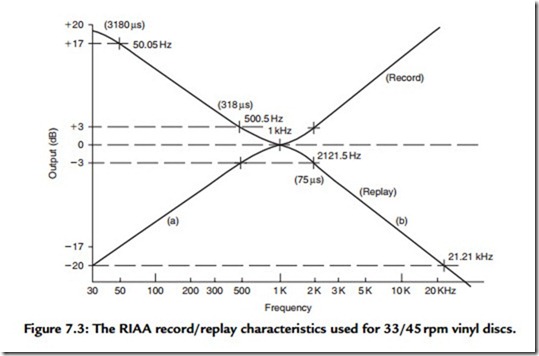Gramophone Pick-Up Inputs
Three broad categories of pick-up (PU) cartridges exist: the ceramic, the moving magnet or variable reluctance, and the moving coil. Each of these has different output characteristics and load requirements.
Ceramic Piezo-Electric Cartridges
These units operate by causing the movement of the stylus due to groove modulation to flex a resiliently mounted strip of piezo-electric ceramic, which then causes an electrical voltage to be developed across metallic contacts bonded to the surface of the strip. They are commonly found only on low-cost units and have a relatively high output signal level, in the range 100–200 mV at 1 kHz.
Generally, the electromechanical characteristics of these cartridges are tailored so that they give a fairly flat frequency response, although with some unavoidable loss of HF response beyond 2 kHz, when fed into a preamplifier input load of 47,000 ohms.
Neither the HF response nor the tracking characteristics of ceramic cartridges are particularly good, although circuitry has been designed with the specific aim of optimizing the performance obtainable from these units.1 However, in recent years, the continuing development of PU cartridges has resulted in a substantial fall in the price of the less exotic moving magnet or variable reluctance types so that it no longer makes economic sense to use ceramic cartridges, except where their low cost and robust nature are of importance.
Moving Magnet and Variable Reluctance Cartridges
These are substantially identical in their performance characteristics and are designed to operate into a 47-K load impedance, in parallel with some 200–500 pF of anticipated lead capacitance. Since it is probable that the actual capacitance of the connecting leads will only be of the order of 50–100 pF, some additional input capacitance, connected across the phono input socket, is customary. This also will help reduce the probability of unwanted radio signal breakthrough.
PU cartridges of this type will give an output voltage that increases with frequency in the manner shown in Figure 7.3(a), following the velocity characteristics to which
LP records are produced, in conformity with the Recording Industry Association of America (RIAA) recording standards. The preamplifier will then be required to have a gain/frequency characteristic of the form shown in Figure 7.3(b), with the deemphasis time constants of 3180, 318, and 75 μs, as indicated in the figure.
The output levels produced by such PU cartridges will be of the order of 0.8–2 mV/cm/s of groove modulation velocity, giving typical mean outputs in the range of 3–10 mV at 1 kHz.
7.3.3 Moving Coil Pick-Up Cartridges
These low-impedance, low-output PU cartridges have been manufactured and used without particular comment for very many years. They have come into considerable prominence in the past decade because of their superior transient characteristics and dynamic range as the choice of those audiophiles who seek the ultimate in sound quality, even though their tracking characteristics are often less good than is normal for MM and variable reluctance types.
Typical signal output levels from these cartridges will be in the range 0.02–0.2 mV/cm/s into a 50- to 75-ohm load impedance. Normally, a very low-noise head amplifier circuit will be required to increase this signal voltage to a level acceptable at the input of the RIAA equalization circuitry, although some of the high output types will be capable of operating directly into the high-level RIAA input. Such cartridges will generally be designed to operate with a 47-K load impedance.
